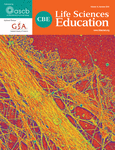Exploring the MACH Model’s Potential as a Metacognitive Tool to Help Undergraduate Students Monitor Their Explanations of Biological Mechanisms
Abstract
When undergraduate biology students learn to explain biological mechanisms, they face many challenges and may overestimate their understanding of living systems. Previously, we developed the MACH model of four components used by expert biologists to explain mechanisms: Methods, Analogies, Context, and How. This study explores the implementation of the model in an undergraduate biology classroom as an educational tool to address some of the known challenges. To find out how well students’ written explanations represent components of the MACH model before and after they were taught about it and why students think the MACH model was useful, we conducted an exploratory multiple case study with four interview participants. We characterize how two students explained biological mechanisms before and after a teaching intervention that used the MACH components. Inductive analysis of written explanations and interviews showed that MACH acted as an effective metacognitive tool for all four students by helping them to monitor their understanding, communicate explanations, and identify explanatory gaps. Further research, though, is needed to more fully substantiate the general usefulness of MACH for promoting students’ metacognition about their understanding of biological mechanisms.



